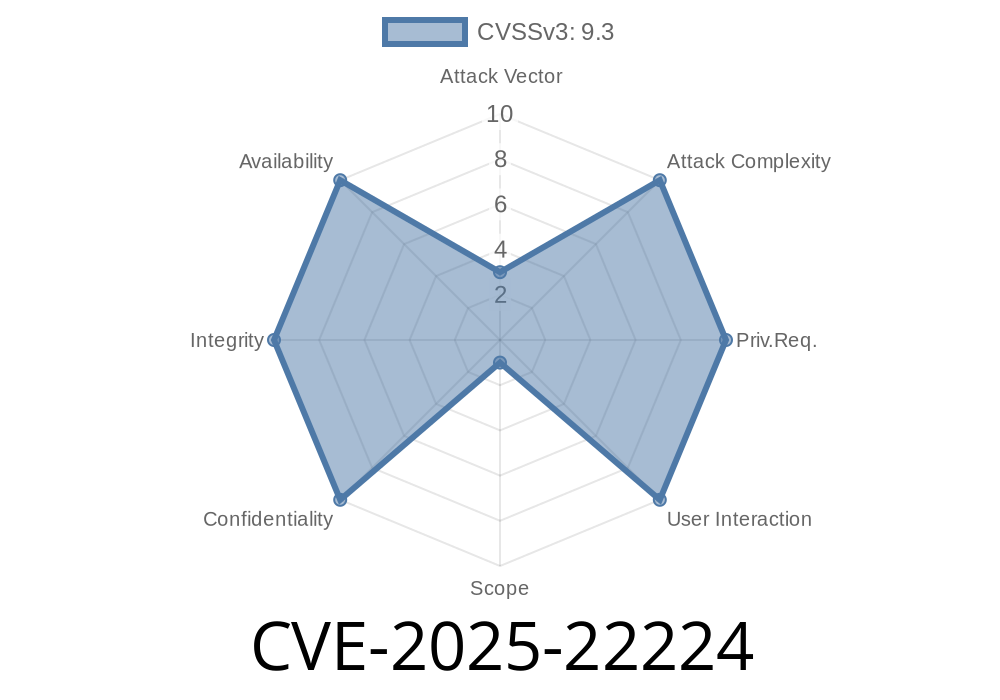A newly discovered vulnerability (CVE-2025-22224) in VMware's ESXi and Workstation products has been making waves in the cybersecurity community. The vulnerability, classified as a TOCTOU (Time-of-Check Time-of-Use) issue, allows a malicious actor with local administrative privileges on a virtual machine (VM) to execute code as the VM's VMX process running on the host.
In this post, we will discuss the details of this vulnerability, its impact on affected systems, and what administrators should be aware of when managing their virtual environments.
What is CVE-2025-22224?
CVE-2025-22224 is a vulnerability affecting VMware ESXi and Workstation products that could lead to an out-of-bounds write due to a TOCTOU issue. This vulnerability can be exploited by a malicious actor with local admin privileges on a VM to execute code as the VMX process running on the host.
TOCTOU Vulnerability Explained
A TOCTOU (Time-of-Check, Time-of-Use) vulnerability occurs when a software system or application checks the state of a resource, such as a file or memory location, and makes a decision based on that state, but there is a time gap between the check and the actual use of the resource. During this gap, a malicious attacker can manipulate the resource, causing the system to behave unexpectedly.
In the case of CVE-2025-22224, the vulnerability arises because the VMware software does not properly handle user-supplied input, leading to the TOCTOU issue and allowing an attacker to exploit the out-of-bounds write.
Exploit Details
A malicious actor with local admin privileges on a VM can exploit CVE-2025-22224 to execute code as the VMX process running on the host. The following code snippet demonstrates how a malicious actor might exploit this vulnerability:
#include <stdio.h>
#include <unistd.h>
int main() {
char exploit_code[] = { /* ... */ };
/* insert malicious code to be executed as VMX process */
if (fork() == ) { /* create a child process */
usleep(100); /* introduce a delay */
trigger_out_of_bounds_write(exploit_code);
/* function to trigger the vulnerability and manipulate memory */
} else {
check_and_use_resource();
/* function to check the state of the resource and use it */
}
return ;
}
The above code snippet shows a simple example of how an attacker might exploit the TOCTOU vulnerability. The fork() system call is used to create a child process that runs concurrently with the original process. The child process introduces a short delay using usleep() and then invokes trigger_out_of_bounds_write() to exploit the vulnerability and manipulate memory. Meanwhile, the original process calls check_and_use_resource() to check the state of a resource and use it. Due to the time gap between the check and use, the attacker's exploit code will be executed as the VMX process.
The following sources provide more detail on the CVE-2025-22224 vulnerability and mitigation steps
1. VMware Security Advisory VMSA-2025-0001: https://www.vmware.com/security/advisories/VMSA-2025-0001.html
2. CVE-2025-22224: https://cve.mitre.org/cgi-bin/cvename.cgi?name=CVE-2025-22224
3. NIST NVD entry for CVE-2025-22224: https://nvd.nist.gov/vuln/detail/CVE-2025-22224
Recommendations
Organizations that use the affected VMware products should immediately review their security posture and apply the relevant patches provided by VMware as soon as possible. Additionally, administrators should follow best practices for securing virtual environments, including regularly monitoring privileges and limiting access to virtual machines to only trusted users.
In conclusion, CVE-2025-22224 is a critical vulnerability that can potentially lead to unauthorized code execution within a VM's VMX process on the host. To protect against this vulnerability, organizations should apply available patches and follow best practices for securing their virtual environments.
Timeline
Published on: 03/04/2025 12:15:33 UTC
Last modified on: 03/05/2025 02:00:02 UTC
